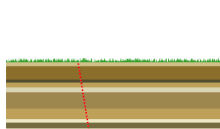Continental collision
This article includes a improve this article by introducing more precise citations. (July 2017) ) |

In
Continental collision is not an instantaneous event, but may take several tens of millions of years before the
Subduction zone: the collision site
The process begins as two
Deep subduction of continental crust
The
Orogeny and collapse

An
The pace of mountain building associated with the collision is measured by
Far-field effects
The effects of the collision are felt far beyond the immediate site of collision and mountain-building. As convergence between the two continents continues, the region of crustal thickening and elevation will become broader. If there is an oceanic free face, the adjacent crustal blocks may move towards it. As an example of this, the collision of India with Asia forced large regions of crust to move south to form modern
Fossil collision zones
Continental collisions are a critical part of the supercontinent cycle and have happened many times in the past. Ancient collision zones are deeply eroded but may still be recognized because these mark sites of intense deformation, metamorphism, and plutonic activity that separate tracts of continental crust having different geologic histories prior to the collision. Old collision zones are commonly called "suture zones" by geologists, because this is where two previous continents are joined or sutured together.
References
- Ernst, W.G. (2006). "Preservation/exhumation of ultrahigh-pressure subduction complexes". .
- Ernst, W.G.; Maruyama, S. Wallis; Wallis, S. (1997). "Buoyancy-driven, rapid exhumation of ultrahigh-pressure metamorphosed continental crust". Proceedings of the National Academy of Sciences. 94 (18): 9532–9537. PMID 11038569.
- O'Brien, P.J. (2001). "Subduction followed by collision; Alpine and Himalayan examples". Physics of the Earth and Planetary Interiors. 127 (1–4): 277–291. .
- Toussaint, G.; Burov, E.; Avouac, J.-P. (2004). "Tectonic evolution of a continental collision zone: A thermomechanical numerical model" (PDF). Tectonics. 23 (6): TC6003. S2CID 18607619.
- Song, S.G. (2014). "Continental orogenesis from ocean subduction, continent collision/subduction, to orogen collapse, and orogen recycling: The example of the North Qaidam UHPM belt, NW China". Earth-Science Reviews. 129 (3–4): 59–84. .
